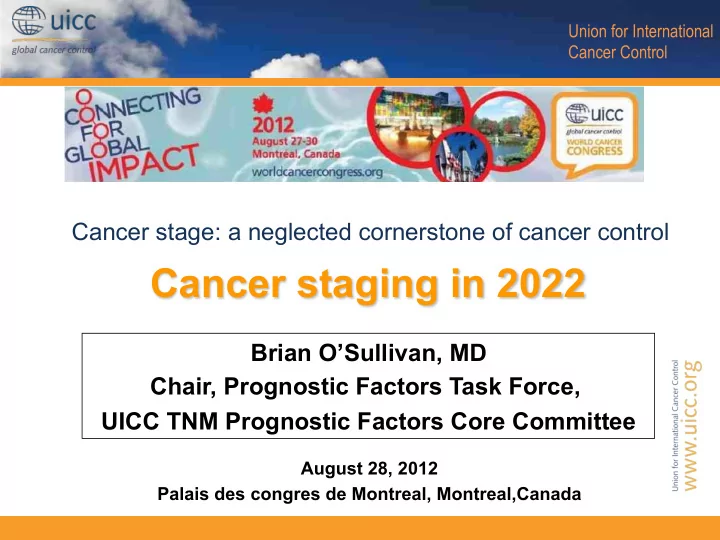

Union for International Cancer Control Cancer stage: a neglected cornerstone of cancer control Cancer staging in 2022 Brian O’Sullivan, MD Chair, Prognostic Factors Task Force, UICC TNM Prognostic Factors Core Committee August 28, 2012 Palais des congres de Montreal, Montreal,Canada
Union for International Cancer Control TNM – A Universal Language
Union for International Cancer Control Does the need for TNM staging change over time ? Likert scales 1-7 622 oncologists Basically: communication, prognosis, treating patients, evaluate results
Union for International Cancer Control TNM provides different needs to different groups • Clinical trials eligibility and Viewed through different stratification lenses by different groups: • Defining and monitoring use of experts in one area must clinical practice guidelines • Translational research appreciate the needs of • Health services and registry other groups who also use uses including early successes TNM of screening • Discussing / defining treatment of individual patients in clinics and conferences (tumor boards) Southeast Center for Education in the Arts • Fiscal and policy development of cancer programs Mackillop WJ, O’Sullivan B, Gospodarowicz M, The Role of Cancer Staging in Evidence- based Medicine Cancer Prev Control, 2(6) 269-77, 1998
Union for International Cancer Control Aims of the Staging Classification 1. To aid the clinician in the planning of treatment 2. To give some indication of prognosis 3. To assist in evaluation of the results of treatment 4. To facilitate the exchange of information between treatment centres 5. To contribute to the continuing investigation of human cancer 6. To support cancer control activities (new in 7 th edition) UICC TNM Classification of Malignant Tumours, 7 th edition, 2009
Union for International Cancer Control Limit Limitations ions of of TNM NM Cancer ancer Staging ging • Does not describe biology of cancer • Does not fully predict response to chemotherapy and targeted therapy • Misuse is frequent in implementation of TNM and in attempts to modify or develop new classifications
Union for International Cancer Control Cancer Prevention and Control 1998
Union for International Cancer Control Dilemma in TNM staging: • Frequent revisions to include new biomarkers would undermine the value conferred by the stability and universality of TNM • A static formulation of TNM risks falling behind the state of the art in diagnostic techniques, biological concepts and biomarkers
Union for International Cancer Control Prognos ognostic ic Fact actor ors in in Cancer ancer • Non-anatomic prognostic factors are poorly integrated and this area needs attention: – No uniform system for classification available – Need to develop “taxonomy” to address this domain that does not rely solely on the TNM scaffold • From time to time we hear statements : – Stage classification should be modified, or discarded / eliminated because of new molecular discoveries (usually in a selected area) – These statements are only useful to underline the need to address this challenge
Union for International Cancer Control Cancer ancer Prognos ognostic ic Clas lassif ifica ication: ion: New New Tax axonomy onomy will ill Evolv olve e in in ne next xt 10 10 year ears • Tumour anatomic extent (Staging) • Size, depth of invasion, metastasis, location, number of lesions • Expressed by TNM classification • Tumour profile (Profiling) • Histopathologic type, grade • Molecular markers and gene expression patterns • Hormone receptor status • Proliferation markers • Prognostic Index (Prognostic Risk Grouping) • Combines Profiling, Staging, Patient and Environmental factors • Usually for Subgroups and is Scenario-specific
Union for International Cancer Control Useful in individual patients, with selected criteria (e.g. resected disease) for a specific purpose (decision for chemotherapy) Not yet useful for managing / stratifying / analysing groups of patients (see other goals of staging)
Union for International Cancer Control
Union for International Cancer Control
Union for International Cancer Control Need to create Prognostic Risk Groups for different scenarios that address interventions and relevant end-points Patient / Host Characteristics Anatomic Disease Tumor Profile Characteristics Characteristics Treatment / Environment Characteristics
Union for International Cancer Control Standardisation of TNM to meet registration needs in different juristictions The UICC should examine how mapping from TNM to “localised, regional, distant” systems could be made explicit and standardised for all cancers. S Walters et al Accepted IJC
Union for International Cancer Control ICD 11 5 th Character Section Malignant neoplasms: Section malignant:-- 1: Stage I 2: Stage II 3: Stage III 4: Stage IV 9: Unknown, unspec, not app A: Remission/Free of disease B: Local disease C: Regional disease D: Distant disease Note in situ has its own section
Union for International Cancer Control Cancer Staging in 2022 • Will continue to evolve and maintain its anatomic basis to permit new biological and other findings to be evaluated • Will continue to support the numerous needs of varying constituents that need anatomic stage • Will be combined with Tumor , Host , and Environmental factors to create Prognostic Risk Groups for different cancer situations
Union for International Cancer Control Acknowledgements • The members of the UICC TNM Prognostic Factors Core Committee • Colleagues at the AJCC and its Task Forces
Union for International Cancer Control Prediction • Prediction is very difficult, especially about the future. – Niels Bohrs (Physicist) • The best way to predict the future is to invent it. – Alan Kay (Computer Scientist)
Recommend
More recommend